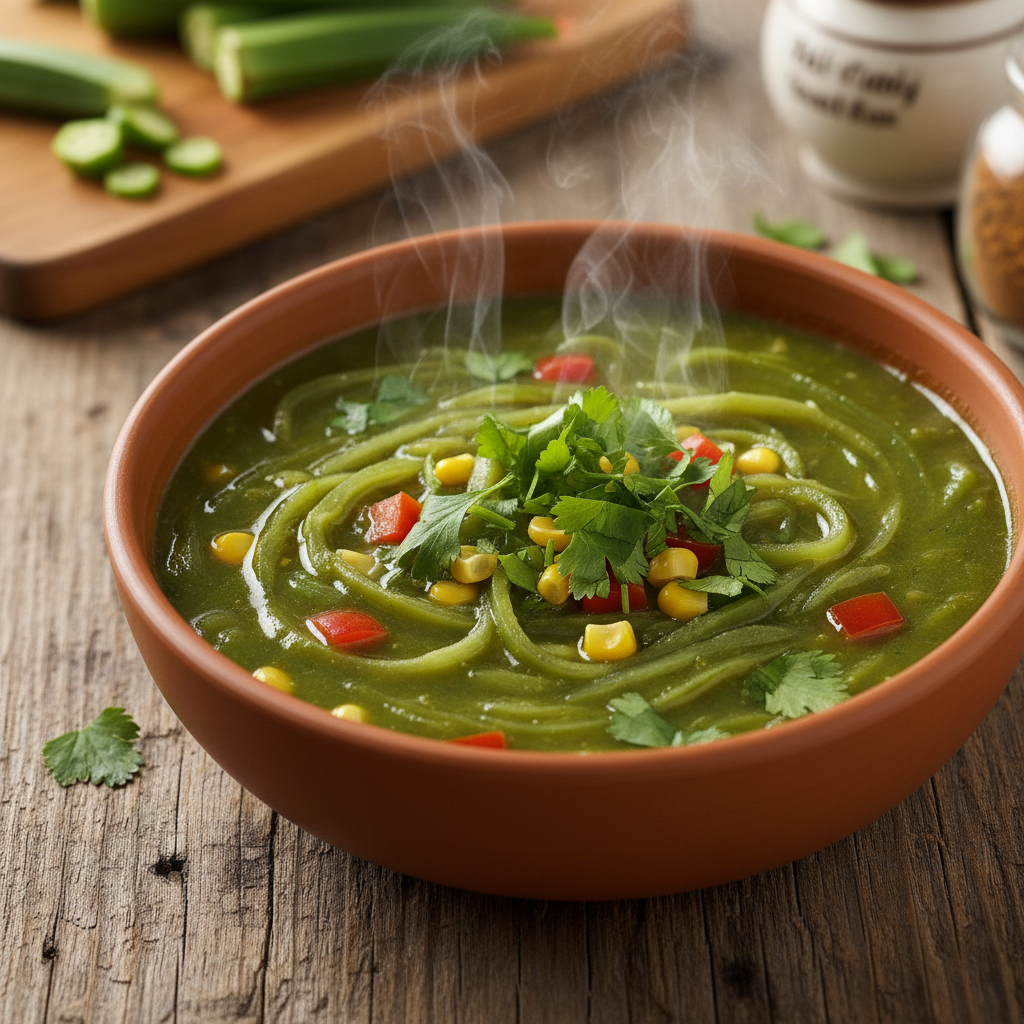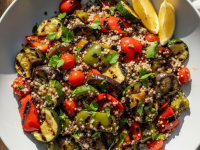Hey there, fellow food adventurers! Have you ever stood in your kitchen, staring at vegetable scraps, and wondered, “Is there *really* nothing else I can do with this?” I know I have. We live in a world where reducing food waste is not just a trend, but a necessity, and honestly, a fun challenge for any home cook. That’s precisely how I stumbled upon one of the most surprising, flavorful, and incredibly satisfying recipes I’ve ever created: Okra Skin Soup.
Now, I know what you might be thinking. “Okra *skin* soup? Is that even a thing?” Trust me, that was my exact reaction too! Like many of you, I’ve enjoyed okra in countless ways – stewed, fried, grilled, in gumbos. But usually, the focus is on the whole pod, sometimes even trying to minimize its unique mucilage. One day, while preparing okra for a different dish, I started thinking about the outer part – the vibrant green skin, the fibrous structure. It seemed a shame to waste it, especially if I was deseeding the pods for a specific, less-slimy preparation. So, driven by curiosity and a commitment to zero-waste cooking, I embarked on an experiment. And let me tell you, the results were not just good; they were absolutely fantastic. This isn’t just a recipe; it’s a testament to the hidden potential in every part of our produce.
The “Why”: More Than Just Reducing Waste
Before we dive into the delicious details, let’s talk about the philosophy behind this soup. For me, it started with a simple desire to be more mindful in my kitchen. We often discard peels, stems, and outer layers without a second thought. But these parts frequently hold significant nutritional value and unique flavors that we’re missing out on. Okra skin, for instance, is packed with fiber, vitamins, and antioxidants. By focusing on it, we’re not just saving food from the bin; we’re actually unlocking a new layer of nutrition and taste.
Beyond the nutritional aspect, there’s the sheer joy of discovery. This soup has a completely different character than traditional okra soups. Because we’re emphasizing the outer, firmer part of the pod, the soup tends to be less overtly “slimy” (a texture many people are wary of) and offers a more robust, earthy flavor. It’s an opportunity to experience okra in a fresh, unexpected way, turning what might be considered a scrap into the star of the show.
“Skiing” Okra: My Method for Maximum Flavor (and Minimal Waste)
Okay, let’s address the elephant in the room: how exactly do you get “okra skins” for a soup? You’re not peeling them like potatoes, I promise! My approach hinges on maximizing the use of the outer, greener, and often firmer parts of the okra pod. Here’s how I prepare them:
- For Tender, Younger Okra: If you have access to small, tender okra, this is the easiest route. Simply wash them thoroughly and trim off the very top stem and a tiny bit from the tip. Then, using a mandoline or a very sharp knife, slice the okra into paper-thin rounds. The thier, the better! This way, you’re using the whole pod, but the “skin” (the green outer layer) becomes the predominant texture in the soup, and the mucilage is much less noticeable.
- For Larger Okra (If Deseeding): If you’re using larger okra and have a separate use for the seeds (perhaps for a specific stew where you want to control thickness, or if you simply prefer less “slime”), you can carefully slice the okra lengthwise and gently scoop out the seeds and ier mucilaginous pulp with a spoon. What you’re left with is the outer “skin” – the firm, green shell of the okra pod. You can then thinly slice or even finely chop these “skins.” This is the most literal interpretation of “okra skin” for the soup.
- My Preferred Everyday Method: I usually go with the first option, slicing tender, young okra very thinly. It’s less work and yields a fantastic result that really highlights the outer part of the okra. Whichever method you choose, the goal is to get those green, outer layers ready to release their unique flavor into your broth.
The Flavor Profile: What to Expect from This Unique Soup
Prepare your taste buds for something special! Unlike the classic thick and gooey okra stews, this Okra Skin Soup offers a lighter, fresher, yet still deeply satisfying experience. You’ll notice:
- A Clean, Earthy Taste: The soup has a wonderful green, slightly grassy, and earthy flavor that is incredibly refreshing.
- Minimal “Sliminess”: Because we’re focusing on the outer layers and thinly slicing, the mucilage is much less pronounced, making it appealing even to those who typically shy away from okra’s texture.
- Hearty Yet Light: It’s a soup that feels nourishing and wholesome without being overly heavy.
- A Canvas for Other Flavors: The mild base of the okra skin provides an excellent foundation for herbs, spices, and other vegetables to shine.
My Go-To Okra Skin Soup Recipe: From Waste to Wholesome Goodness
Ready to transform those overlooked parts of okra into a culinary masterpiece? Here’s my tried-and-true recipe. Feel free to adjust the spices to your preference!
Ingredients:
- 2 tablespoons olive oil or vegetable oil
- 1 large onion, finely chopped
- 2 cloves garlic, minced
- 1 red bell pepper, diced (optional, but adds color and sweetness)
- 1 carrot, finely diced (optional, for extra depth)
- 4-5 cups “okra skins” (about 1.5 lbs small to medium okra, thinly sliced, or equivalent prepared large okra skins)
- 1 teaspoon ground cumin
- ½ teaspoon smoked paprika
- ¼ teaspoon cayee pepper (or to taste, for a little kick)
- 6 cups vegetable broth (or chicken broth, if preferred)
- 1 (14.5 ounce) can diced tomatoes, undrained
- ½ cup fresh corn kernels (frozen is fine too)
- Salt and freshly ground black pepper to taste
- Fresh parsley or cilantro, chopped, for garnish
- A squeeze of fresh lime or lemon juice, for brightness (optional)
Instructions:
- Prepare Your Okra: As discussed above, wash and prepare your okra “skins” – either by thinly slicing whole tender okra or by using the outer parts of deseeded larger pods. Set aside.
- Sauté Aromatics: In a large pot or Dutch oven, heat the olive oil over medium heat. Add the chopped onion and cook until softened and translucent, about 5-7 minutes. Add the minced garlic, diced bell pepper, and carrot (if using) and cook for another 3-5 minutes, until slightly tender and fragrant.
- Add Spices: Stir in the ground cumin, smoked paprika, and cayee pepper. Cook for about 1 minute, stirring constantly, until the spices are fragrant. This step really helps to bloom the flavors!
- Introduce Okra and Liquids: Add your prepared “okra skins” to the pot. Stir well to combine with the aromatics and spices. Pour in the vegetable broth and the caed diced tomatoes (with their juice). Bring the mixture to a gentle boil, then reduce the heat to low, cover, and simmer for 15-20 minutes, or until the okra is tender. The goal is tender, not mushy.
- Finish with Corn: Stir in the fresh or frozen corn kernels and continue to simmer for another 5 minutes, allowing the corn to cook through and the flavors to meld beautifully.
- Season and Serve: Taste the soup and season generously with salt and freshly ground black pepper. Remember, broth can vary in saltiness, so always taste and adjust. Ladle the hot soup into bowls. Garnish with fresh parsley or cilantro and, if you like a little zing, a squeeze of fresh lime or lemon juice. Enjoy your surprisingly delicious, zero-waste creation!
Tips for Success and Creative Variations
This recipe is incredibly versatile, and I encourage you to make it your own! Here are a few tips and ideas:
- Don’t Overcook: Unlike some stews where okra can become very soft, for this soup, you want the okra skins to retain a slight bite and texture. Keep an eye on it!
- Embrace the Freshness: The freshness of the okra really shines through here. Don’t be afraid to add extra fresh herbs at the end.
- Spice it Up: Want more heat? Add extra cayee or a pinch of red pepper flakes. For an Indian-inspired twist, add a teaspoon of garam masala with your other spices. A touch of ginger can also be wonderful.
- Make it Heartier: You can easily transform this into a more substantial meal by adding a can of drained and rinsed caellini beans or chickpeas during the last 10 minutes of simmering. Leftover shredded chicken or cooked sausage would also be a great addition.
- Creamy Option: For a touch of creaminess, stir in a swirl of coconut milk or a tablespoon of plain yogurt (after removing from heat) just before serving.
The Nutritional Benefits You’re Not Throwing Away
Let’s not forget the health angle! By utilizing the “skins” of okra, you’re tapping into a powerhouse of nutrients:
- Fiber Rich: Okra, especially its outer layers, is an excellent source of dietary fiber, which is crucial for digestive health, helps regulate blood sugar, and keeps you feeling full.
- Vitamins and Minerals: It provides a good dose of Vitamin C (an antioxidant powerhouse), Vitamin K (important for blood clotting and bone health), and folate.
- Antioxidants: Okra contains various antioxidants like polyphenols and flavonoids, which help combat free radicals in the body and reduce inflammation.
- Low Calorie: This soup is generally low in calories and fat, making it a guilt-free addition to a healthy diet.
Conclusion: A Discovery Worth Making
So there you have it – my unexpected journey to creating a truly delightful Okra Skin Soup. It’s more than just a recipe; it’s a philosophy. It’s about looking at every part of our food with fresh eyes, challenging assumptions, and finding deliciousness where we least expect it. This soup has become a staple in my kitchen, a warm reminder that creativity and mindful cooking can turn simple ingredients, even those often discarded, into something truly special.
I genuinely encourage you to give this a try. Don’t be afraid to experiment, to tweak, and to make it your own. You might just find your new favorite soup, and in doing so, contribute to a more sustainable, flavorful kitchen. Happy cooking, and may your culinary adventures always be full of delightful surprises!




